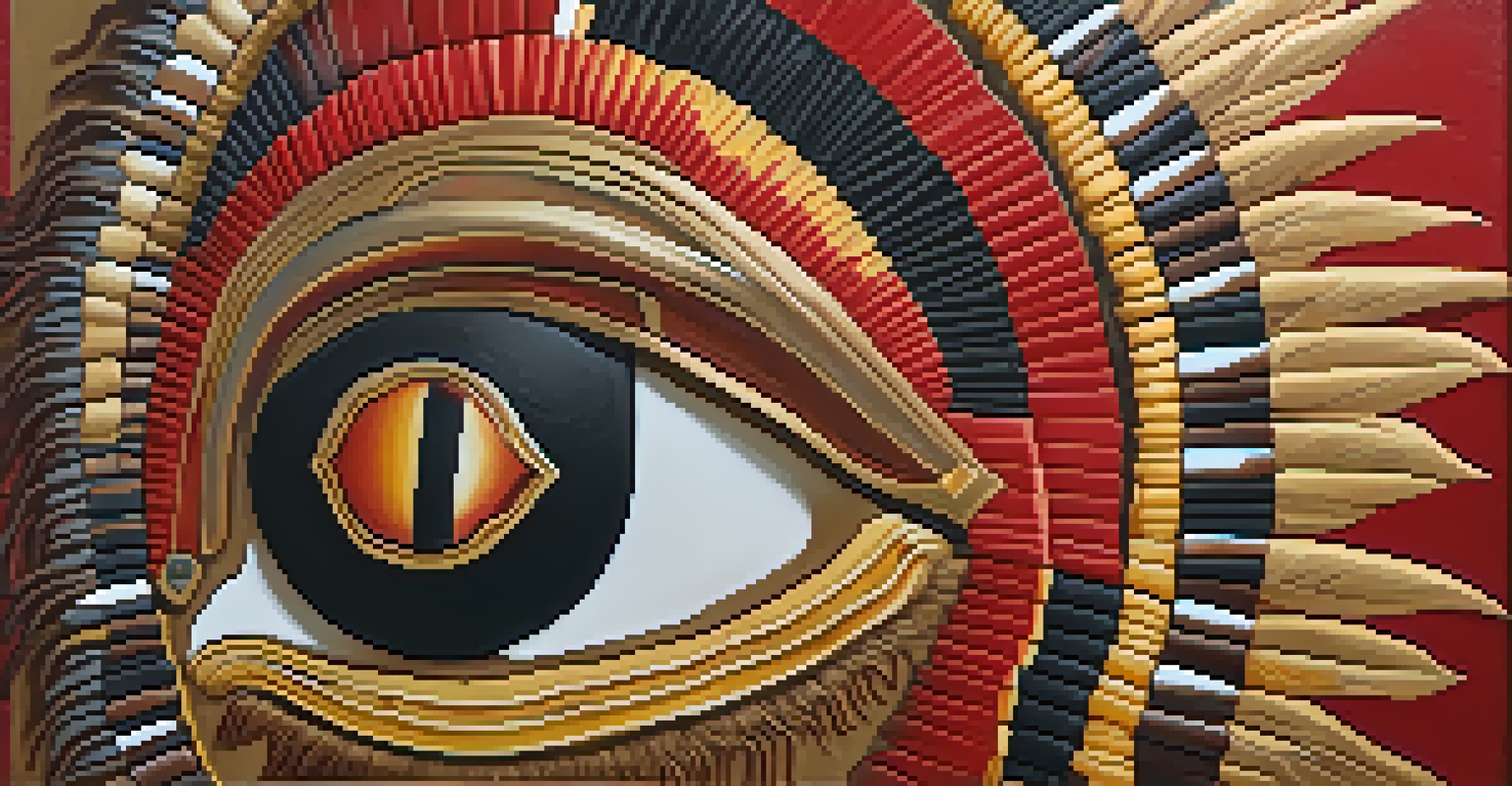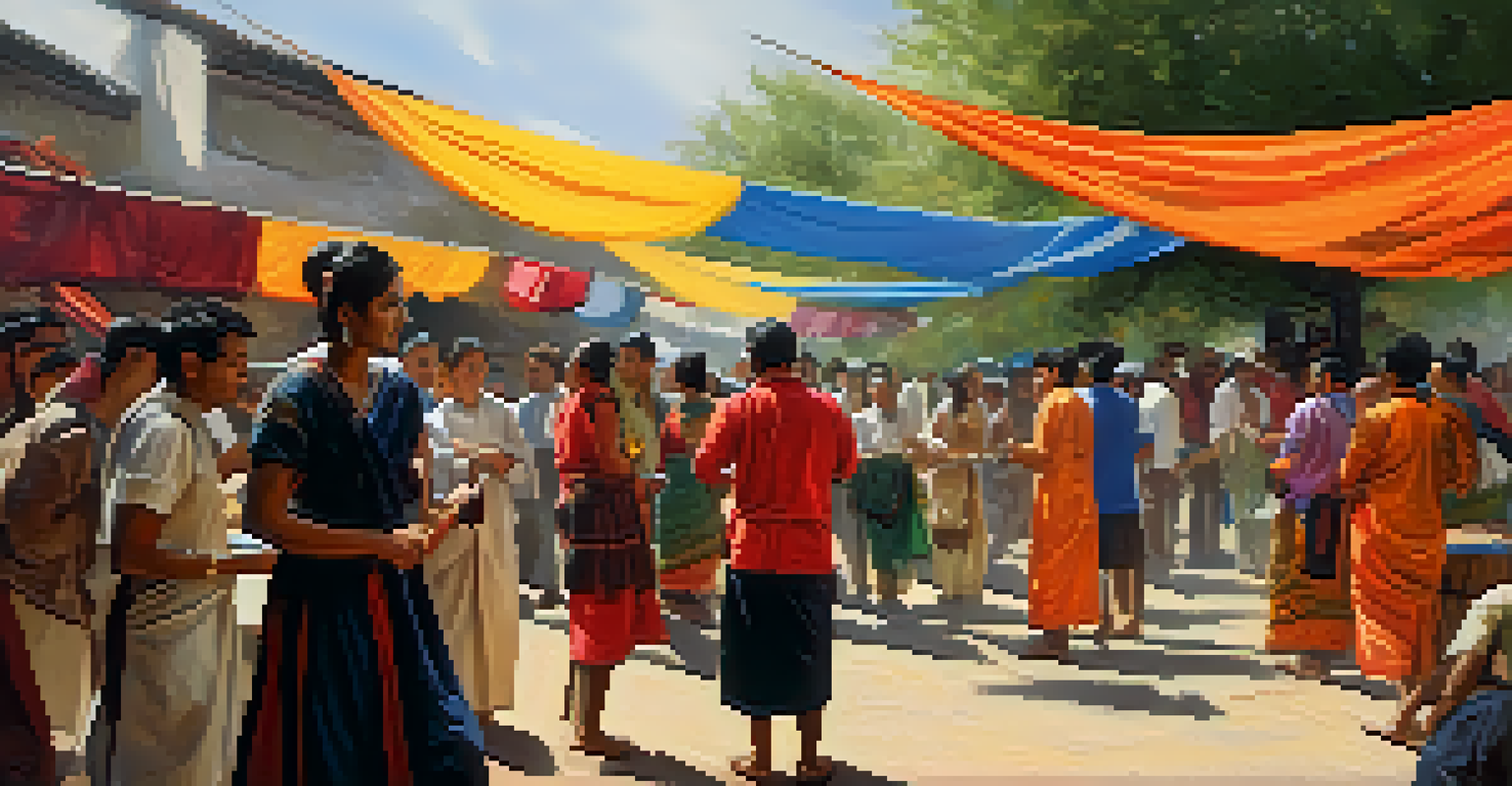Cultural Significance of Traditional Painting Practices

Understanding Traditional Painting and Its Roots
Traditional painting refers to artistic techniques and styles passed down through generations, often rooted in the cultural heritage of a community. These practices encapsulate the history, values, and beliefs of a society, making them a vital aspect of cultural identity. For instance, indigenous art often tells stories of creation and connection to the land, reflecting a deep relationship with nature.
Art is the most beautiful of all lies.
The techniques used in traditional painting can vary widely, from the intricate brushwork of Asian calligraphy to the vibrant colors of African tribal art. Each method not only showcases artistic skill but also serves a purpose, such as rituals or storytelling. This connection between art and function highlights the importance of these practices in maintaining cultural continuity.
As we explore these traditional practices, we gain insight into the community's worldview and social structures. Understanding these artistic expressions helps us appreciate the diversity and richness of human experience, making it clear that traditional painting is more than just visual art—it's a window into the soul of a culture.
The Role of Symbolism in Traditional Painting
Symbolism plays a crucial role in traditional painting, serving as a bridge between the artist's message and the viewer's interpretation. Different colors, shapes, and patterns often carry specific meanings, deeply rooted in the cultural context. For example, in many Native American cultures, the color red symbolizes strength and vitality, while in Chinese art, it represents good fortune.

Artists often use symbols to convey complex ideas and emotions, allowing viewers to connect with the work on a deeper level. This practice not only preserves cultural narratives but also invites dialogue and reflection among viewers. For instance, a painting depicting a mythical creature may represent the struggle between good and evil, resonating with universal themes that transcend cultural boundaries.
Cultural Heritage Through Art
Traditional painting serves as a vital expression of cultural identity, encapsulating the history and values of communities.
By decoding the symbolism embedded in traditional paintings, we can appreciate the artistry while also honoring its historical significance. This exploration fosters a greater understanding of the cultural heritage that informs these artistic expressions, reminding us that every brushstroke carries a story.
Preservation of Techniques Through Generations
One of the hallmarks of traditional painting practices is the emphasis on preserving techniques through generations. This transmission of knowledge often occurs in communal settings, where elders teach younger artists the intricate skills required to create traditional artworks. Such mentorship not only preserves the craft but also strengthens community bonds.
Every artist dips his brush in his own soul, and paints his own nature into his pictures.
These techniques often include specific methods of paint preparation, application, and the use of natural materials, which are integral to the authenticity of the artwork. For example, many indigenous cultures use locally sourced pigments, which adds a unique character to their work. This connection to the environment highlights the sustainable practices that have been integral to these cultures for centuries.
As modern influences threaten to overshadow traditional methods, efforts to preserve these techniques have become increasingly important. Workshops, cultural festivals, and educational programs play a vital role in ensuring that the next generation inherits this rich artistic legacy, allowing traditional painting to thrive in a contemporary context.
Cultural Identity and Expression Through Art
Traditional painting serves as a powerful tool for cultural identity and expression. For many communities, these artworks are a way to celebrate their heritage and assert their place in the world. By depicting stories, rituals, and significant events, artists create a visual narrative that embodies the essence of their culture.
In times of change or adversity, traditional painting can also act as a form of resistance, helping communities to reclaim their identity and assert their values. For example, Aboriginal artists in Australia have used their art to convey their connection to the land and to advocate for their rights. This form of expression fosters resilience and unity within the community.
Role of Symbolism in Art
Symbolism in traditional painting conveys complex ideas, inviting deeper connections between the artist's message and the viewer's interpretation.
Through traditional painting, cultural identities are not only preserved but also revitalized. This artistic expression encourages dialogue and understanding, reminding us of the importance of cultural diversity in our increasingly globalized world.
Modern Adaptations of Traditional Painting
As cultures evolve, traditional painting practices often adapt to contemporary contexts, blending old techniques with modern themes. Many artists are now incorporating elements of their cultural heritage into contemporary art forms, creating a dialogue between past and present. This fusion not only keeps traditions alive but also allows for innovation and experimentation.
For instance, artists may use traditional motifs in abstract paintings, reinterpreting their significance while still honoring their origins. This approach helps to attract a new audience and makes traditional art relevant in today's society. It also opens up opportunities for cross-cultural collaboration, enriching the artistic landscape.
Through these modern adaptations, traditional painting practices not only survive but thrive, demonstrating their flexibility and resilience. This evolution ensures that the essence of these cultural expressions continues to resonate with future generations.
The Impact of Globalization on Traditional Art
Globalization has a profound impact on traditional painting practices, both positively and negatively. On one hand, it allows for greater exposure and appreciation of diverse artistic styles, as artworks can reach wider audiences through digital platforms and international exhibitions. This visibility can foster interest in traditional methods and encourage cultural exchange.
However, globalization also poses challenges, as mass production and commercialization can threaten the authenticity of traditional art. As demand for quick, inexpensive art rises, there is a risk that unique cultural expressions may be diluted or lose their original meaning. Artists must navigate this complex landscape to preserve their heritage while adapting to new market realities.
Adapting to Modern Contexts
Traditional painting practices are evolving, blending historical techniques with contemporary themes to remain relevant and innovative.
Ultimately, the key lies in finding a balance between embracing global influences and maintaining the integrity of traditional practices. By advocating for ethical consumption and supporting local artists, we can help ensure that these cultural treasures remain vibrant and respected in an interconnected world.
The Future of Traditional Painting Practices
The future of traditional painting practices is both promising and uncertain, as artists and communities continue to navigate the challenges and opportunities presented by a rapidly changing world. With a growing appreciation for cultural heritage, there is a renewed interest in traditional art forms, particularly among younger generations. This enthusiasm can lead to innovative approaches that honor the past while embracing the future.
Educational initiatives and community programs play a pivotal role in sustaining these practices, fostering a sense of pride and ownership among participants. By engaging with traditional techniques, younger artists can contribute to the evolution of their cultural narratives, ensuring that they resonate with contemporary audiences.

As we look to the future, it is essential to support and celebrate traditional painting practices, recognizing their significance in shaping cultural identities. By doing so, we not only preserve these artistic expressions but also enrich our collective human experience, weaving a vibrant tapestry of creativity and heritage.